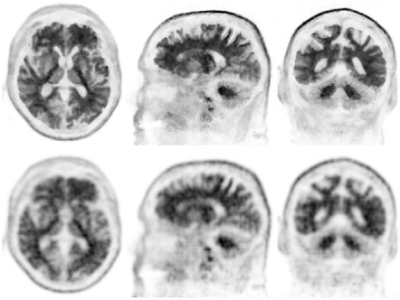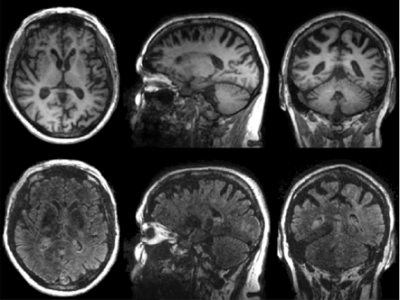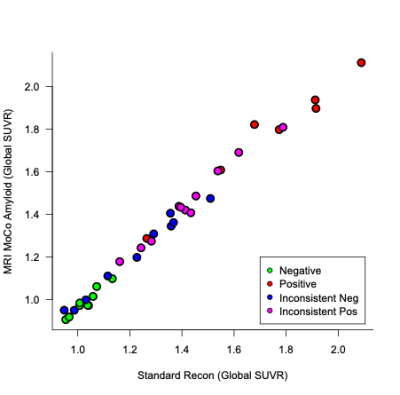5045
PET Recon with MR Priors: Application in Ambiguously Rated Amyloid PET Scans1Radiology, Stanford University, Stanford, CA, United States, 2Neurology, Stanford University, Stanford, CA, United States
Synopsis
A recently developed PET recon with MR priors and motion correction method is applied to a set of ambiguously rated amyloid PET scans and is compared with regular TOF-OSEM PET recon using SUVR. The same comparison is done in a set of scans which were matched by clinical diagnosis. By using PET recon with MR priors, lower SUVRs for negative scans compared to increased SUVRs for positive scans were measured, which shows improvement in the ability to distinguish intermediate amyloid levels.
Objective
Although amyloid PET in a clinical research context is typically interpreted as either positive or negative, a portion of amyloid PET scans fall into an intermediate range and will be rated inconsistently across trained raters. We sought to determine the impact of advanced PET reconstructions that incorporate MRI priors as well as motion correction on semi-quantitative values from these ambiguous scans.Methods
Subject were injected with 300 MBq of florbetaben and underwent a 20-minute brain scan 90 min post injection on a SIGNA PET/MR (GE Healthcare, Waukesha, WI). 3D T1 IR FSPGR and 3D T2 FLAIR CUBE images were acquired simultaneously with PET. The study was approved by Stanford's Institutional Review Board and all subjects provided written consent. PET images were once reconstructed using TOF-OSEM with 28 subsets and 4 iterations using 3 mm FWHM spatial filter and standard Z-filter. They were also reconstructed with MRgTOF-BSREM1,2 with b =15 and bm=100, using motion correction1,3 and 3D T1 and T2 weighted MR images as priors. SUVRs were calculated using a global cortical composite divided by the whole cerebellum for both TOF-OSEM and MRgTOF-BSREM recons. Paired t-tests were used to evaluate the change in SUVR between recons by group.Results
Of 98 florbetaben scans collected, 21 were rated inconsistently across three trained raters (10 were positive for 2/3 raters; 11 were negative for 2/3 raters). The 21 inconsistent scans, along with 16 scans matched for clinical diagnosis that were either consistently read as positive (N=9) or negative (N=7) were reconstructed (Figure 1) using MR priors (Figure 2) and motion correction. SUVRs using standard and MRI-based recon measures were highly correlated (Figure 3). Change in SUVRs (Figure 4) between standard and MRI-based recons significantly differed by rater group, such that the consistently rated negative scans showed lower SUVRs (p=0.0001) and the consistently rated positive scans (p=0.07) showed a trend towards higher SUVRs using the MRI-based recon compared to standard recons. Interestingly, inconsistent scans that were read positive by 2/3 raters showed significant increases in SUVR after MRI-based recons (p=0.026). Inconsistent scans that were read as negative by 2/3 raters showed qualitatively lower SUVRs after MRI based recons, but this difference was not significant (p=0.32).Discussion
MRI-based recons improve semi-quantitative measures of amyloid burden in ambiguously rated cases. We also found changes to consistently rated cases, in the expected direction (lower SUVRs for negative scans compared to increased SUVRs for positive scans). Given how common inconsistent ratings are for amyloid PET, methods that improve the ability to distinguish intermediate amyloid levels are important for the widespread use of this modalityAcknowledgements
No acknowledgement found.References
1. Khalighi MM, Deller T., et al., “High Resolution PET/MR Imaging Using Anatomical Priors & Motion Correction”, ISMRM 2021.
2. Khalighi MM, Deller T., et al., “High Quality Isotropic Whole-body PET Imaging Using MR Priors”, J Nucl Med May 1, 2020 vol. 61 no. supplement 1 1477
3. Spangler-Bickell M. et al., "Rigid Motion Correction for Brain PET/MR Imaging using Optical Tracking", IEEE Transactions on Radiation and Plasma Medical Sciences, Oct 2018.
Figures



